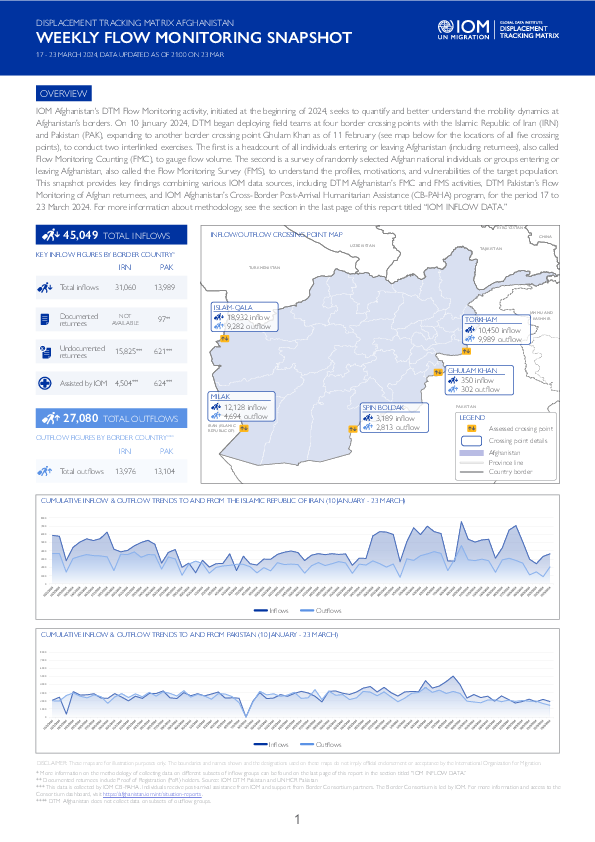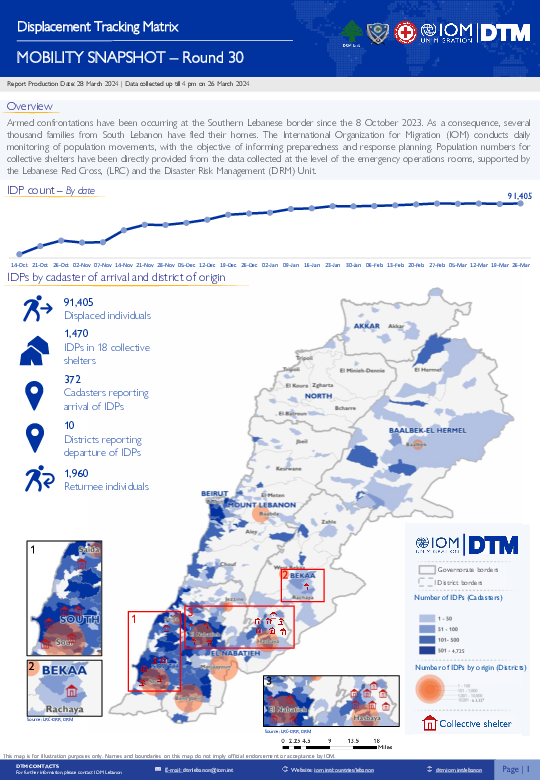-
Countries
-
Data and Analysis
-
Special Focus
-
Crisis Responses

Contact
DTMAfghanistan@iom.int
Language
English
Location
Afghanistan
Period Covered
Mar 17 2024
Mar 23 2024
Activity
- Survey
- Flow Monitoring Survey
- Flow Monitoring
IOM Afghanistan's DTM Flow Monitoring activity, initiated at the beginning of 2024, seeks to quantify and better understand the mobility dynamics at Afghanistan’s borders. On 10 January 2024, DTM began deploying field teams at four border crossing points with the Islamic Republic of Iran (IRN) and Pakistan (PAK), expanding to another border crossing point Ghulam Khan as of 11 February (see map below for the locations of all five crossing points), to conduct two interlinked exercises. The first is a headcount of all individuals entering or leaving Afghanistan (including returnees), also called Flow Monitoring Counting (FMC), to gauge flow volume. The second is a survey of randomly selected Afghan national individuals or groups entering or leaving Afghanistan, also called the Flow Monitoring Survey (FMS), to understand the profiles, motivations, and vulnerabilities of the target population. This snapshot provides key findings combining various IOM data sources, including DTM Afghanistan’s FMC and FMS activities, DTM Pakistan’s Flow Monitoring of Afghan returnees, and IOM Afghanistan’s Cross-Border Post-Arrival Humanitarian Assistance (CB-PAHA) program, for the period 17 to 23 March 2024. For more information about methodology, see the section in the last page of this report titled “IOM INFLOW DATA.”

Contact
dtmlebanon@iom.int
Language
English
Location
Lebanon
Period Covered
Oct 10 2023
Mar 26 2024
Activity
- Mobility Tracking
- Baseline Assessment
Since October 8 there has been an increase in cross-border incidents between Israel and Lebanon, resulting in the displacement of people both within the South and elsewhere within the country. Since October 10, the Displacement Tracking Matrix (DTM) has been conducting the daily monitoring of population movements. The objective of the exercise is to inform preparedness and response planning.

Contact
DTM South Sudan, SouthSudanDTM@iom.int
Language
English
Location
South Sudan
Period Covered
Sep 01 2022
Oct 31 2022
Activity
- Survey
- Return Intention
Between September and October 2022, the International Organization for Migration’s Displacement Tracking Matrix (IOM DTM) undertook its third household-level multi-sector assessment of selected urban areas and camps for internally displaced persons (IDPs) in South Sudan. The assessment aims to:
• Quantify the prevalence of vulnerabilities and humanitarian needs across sectors, with a focus on food security, economic vulnerability and nutrition as well as selected indicators on shelter and non-food items (SNFI), education, health, water, hygiene and sanitation (WASH), protection (including child protection and gender-based violence) and mental health and psycho-social support (MHPSS).
• Generate a better understanding of urban displacement and migration, including return and relocation after displacement in South Sudan or abroad.
There has been slow progress in the humanitarian situation in South Sudan. People’s humanitarian needs continue to rise, driven by cumulative and compounding effects of years of conflict, sub-national violence, food insecurity, climate crisis and public health challenges. Conflict and insecurity, fueled by sub-national and inter-communal violence, crime, and wide-scale impunity, continue to be among the main drivers of humanitarian needs in South Sudan.
Based on the request of the Humanitarian Country Team (HCT), mandated OCHA, IOM, and REACH to implement Inter-Sectoral Needs Assessment that aimed to understand demographics, multi-sectoral needs (including the level of severity) and barriers to assistance as well as displacement patterns and household-level scale.

Contact
DTM South Sudan, SouthSudanDTM@iom.int
Language
English
Location
South Sudan
Period Covered
Sep 01 2022
Oct 31 2022
Activity
- Survey
- Return Intention
Between September and October 2022, the International Organization for Migration’s Displacement Tracking Matrix (IOM DTM) undertook its third household-level multi-sector assessment of selected urban areas and camps for internally displaced persons (IDPs) in South Sudan. The assessment aims to:
• Quantify the prevalence of vulnerabilities and humanitarian needs across sectors, with a focus on food security, economic vulnerability and nutrition as well as selected indicators on shelter and non-food items (SNFI), education, health, water, hygiene and sanitation (WASH), protection (including child protection and gender-based violence) and mental health and psycho-social support (MHPSS).
• Generate a better understanding of urban displacement and migration, including return and relocation after displacement in South Sudan or abroad.
There has been slow progress in the humanitarian situation in South Sudan. People’s humanitarian needs continue to rise, driven by cumulative and compounding effects of years of conflict, sub-national violence, food insecurity, climate crisis and public health challenges. Conflict and insecurity, fueled by sub-national and inter-communal violence, crime, and wide-scale impunity, continue to be among the main drivers of humanitarian needs in South Sudan.
Based on the request of the Humanitarian Country Team (HCT), mandated OCHA, IOM, and REACH to implement Inter-Sectoral Needs Assessment that aimed to understand demographics, multi-sectoral needs (including the level of severity) and barriers to assistance as well as displacement patterns and household-level scale.

Contact
DTM Burundi, DTMBurundi@iom.int
Language
English
Location
Burundi
Period Covered
Mar 10 2024
Mar 16 2024
Activity
- Mobility Tracking
- Event Tracking
La DTM a identifié 5,209 personnes affectées, dont 1,168 personnes déplacées par les vents violents, les inondations, et les pluies torrentielles dans les provinces de Makamba, Cankuzo, Rutana, Rumonge, et Bujumbura Maie.

Contact
DTM Burundi, DTMBurundi@iom.int
Language
English
Location
Burundi
Period Covered
Mar 03 2024
Mar 09 2024
Activity
- Mobility Tracking
- Event Tracking
La DTM a identifié 14,613 personnes affectées, dont 4,881 personnes déplacées par les Inondations, la grêle, les vents violents, et les pluies torrentielles dans les provinces de Bujumbura Rural, Ngozi, Rutana, Makamba, Kirundo, Cankuzo, et Makamba.
Mar 27 2024
Print
Pays côtier d'Afrique de l'Ouest, le Bénin a connu ces dernières années des événements multidimensionnels qui ont entrainé des déplacements de populations, aussi bien internes que transfrontaliers dans certains départements du Nord. Les personnes déplacées et les communautés hôtes font face à des défis majeurs tels que l’accès limité aux services sociaux de base. Les organisations humanitaires travaillent activement pour répondre à ces besoins urgents, en fournissant une assistance rapide et vitale, en soutenant les infrastructures locales et en protégeant les droits des personnes touchées. Cependant la situation demeure préoccupante et nécessite une attention continue et des ressources supplémentaires pour atténuer les souffrances et trouver des solutions durables.
Countries in this response
- Active DTM operation
- Past DTM operation

Contact
DTM Papua New Guinea, iompngmdac@iom.int
Language
English
Location
Papua New Guinea
Period Covered
Mar 01 2024
Mar 20 2024
Activity
- Mobility Tracking
- Baseline Assessment
Enga province in Papua New Guinea continues to grapple with heightened tensions stemming from recurring tribal conflicts. These conflicts have led to extensive damage to various essential infrastructure, including shelters, schools, churches, and healthcare facilities, particularly in the Middle Lai area of the Wapenamanda district. Reports indicate significant casualties and mass displacement of populations due to the ongoing fighting. Security forces, comprising both police and military personnel, are actively engaged in monitoring the situation and conducting awareness campaigns within local communities to mitigate tensions and prevent further violence.
Efforts are being made to prioritize civilian safety and prevent the escalation of hostilities. Tribal conflicts often arise from issues such as land disputes, competition over resources, and inter-clan rivalries. The data collected from 25 wards across three Local Level Government (LLGs) in the Wapenamanda and Wabag districts of Enga Province provides insight into the demographic impact of the recent conflict. Wapenamanda district emerged as the most affected area, hosting the largest number of IDPs with 2,718 individuals from 546 households displaced by the recent conflict. This represents approximately 50% of the total displaced population. Wabag Rural follows closely, accommodating 40% of the IDPs, totalling 2,186 individuals from 436 households. Wabag Urban also experiences displacement, with 549 individuals from 108 households seeking refuge.

Contact
iomcotonou@iom.int
Language
French
Location
Benin
Period Covered
Jun 01 2023
Jul 31 2023
Activity
Pays côtier d'Afrique de l'Ouest, le Bénin a connu ces dernières années des événements multidimensionnels qui ont entrainé des déplacements de populations, aussi bien internes que transfrontaliers dans certains départements du Nord. Les personnes déplacées et les communautés hôtes font face à des défis majeurs tels que l’accès limité aux services sociaux de base. Les organisations humanitaires travaillent activement pour répondre à ces besoins urgents, en fournissant une assistance rapide et vitale, en soutenant les infrastructures locales et en protégeant les droits des personnes touchées. Cependant la situation demeure préoccupante et nécessite une attention continue et des ressources supplémentaires pour atténuer les souffrances et trouver des solutions durables.
Afin de trouver des réponses durables aux déplacements internes et de prévenir de nouveaux déplacements dans les départements, il s’avère essentiel de comprendre les niveaux de stabilité dans les lieux accueillant les populations déplacées. L'OIM Bénin en liaison avec le bureau régional de l’Afrique de l'Ouest et du centre, a lancé l’Indice de solution et de mobilité (ISM) en 2023 pour évaluer la stabilité des zones accueillant les populations déplacées dans les communes de Banikoara, Cobly, Karimama, Kérou, Matéri et Tanguiéta. L’ISM mesure les perceptions de stabilité et analyse les facteurs qui influencent les décisions des populations de rester ou de se déplacer. Il offre un outil permettant aux autorités et aux partenaires de développer de meilleures stratégies, de prioriser les ressources et de planifier les interventions dans les zones fragiles et instables, en intégrant les approches humanitaires, de relèvement et de stabilisation.
L’Indice de Solution et de Mobilité (ISM) cherche à comprendre quels facteurs influencent la stabilité d’un lieu, ce qui éclaire les interventions programmatiques prioritaires le long du lien humanitaire, de paix et de développement afin de renforcer la résilience et la stabilité et de prévenir de futurs déplacements forcés.
Ce rapport présente les résultats du premier round de l’indice de solution et de mobilité dans les communes de Banikoara, Cobly, Karimama, Kérou, Matéri et Tanguiéta.
